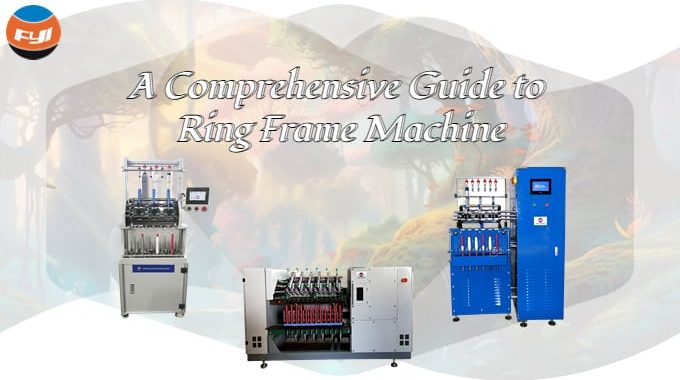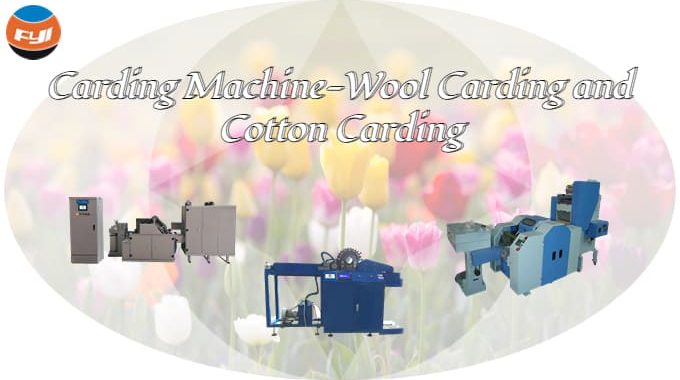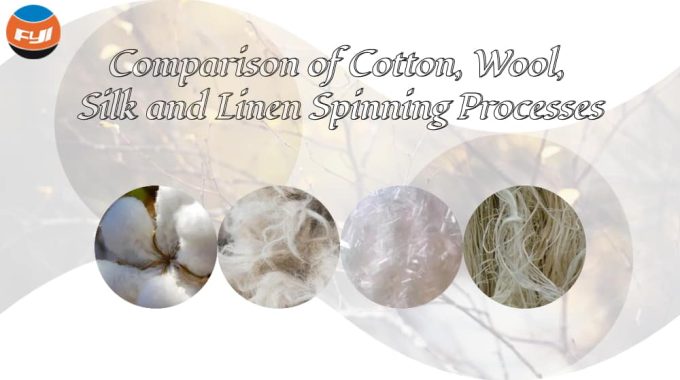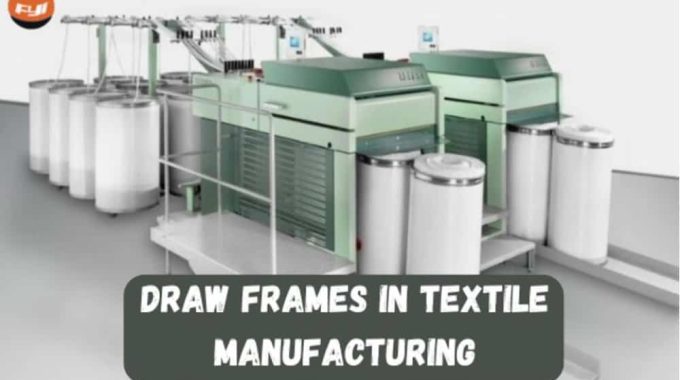
Comprehensive Guide to Draw Frames in Textile Manufacturing
Do you want to know how yarn becomes so smooth and even? Or what machines convert loose fibers into high-quality yarn?
In textile manufacturing, one of the most important machines is the DRAW FRAME. It plays an essential role between the carding and spinning stages by straightening the fibers, mixing, and making the sliver more even. These steps help to get strong and consistent yarn.
As the textile industry is growing more, modern draw frames now come with smart features like autolevelling systems, microwave sensors, and computer-based monitoring. These technologies make the production process faster, better, and more convenient.
People who are working in textile research, teaching, or factory operations, knowing how draw frames work is very necessary. It can help upgrade production, solve quality problems, and teach students the spinning basics. Whether you are setting up a lab or checking yarn quality in a spinning mill, understanding draw frames is a must.
This easy-to-follow guide will walk you through what draw frames are, how they work, and what new features they offer today. It gives useful tips for textile professionals so they can better use and understand this key part of the spinning process. Let’s dive straight into the blog:
Contents
- 1 What Is a Draw Frame and Why Is It Important?
- 2 Classification of Draw Frames
- 3 Draw Frames – Based on Technology
- 4 Types of Draw Frames Based on Their Role in the Production Line
- 5 How a Draw Frame Works and How It’s Tested?
- 6 How Is Draw Frame Performance Tested?
- 7 Performance and Technical Parameters of Draw Frames
- 8 Recent Technological Developments in Draw Frames
- 9 Product Quality and Brand Reputation
- 10 Price, Cost-effectiveness, and Maintenance Requirements
- 11 Conclusion
- 12 Frequently Asked Questions
What Is a Draw Frame and Why Is It Important?
Want to know how loose, fluffy cotton changes into smooth, strong yarn? The making of yarn start with straightening the fibers, mixed well, and made the sliver even. That’s exactly what a draw frame does.
Fiber slivers (long, loose strands of fiber) are consolidated into one by this machine, which makes it more consistent and ready for spinning.
The draw frame is critical due to:
- It improves fiber orientation.
- It ensures sliver uniformity, which is main for yarn quality.
- It minimizes irregularities that may impact downstream processes.
By producing uniform slivers, the draw frame helps manufacturers to get stronger, smoother yarn with fewer defects.
Classification of Draw Frames
Now let’s have a look at different types of draw frames that are used depending on the kind of fiber being processed. Each machine is designed to match the specific needs of cotton, wool, or man-made fibers. These are:
1. Cotton Draw Frame
Cotton draw frames are used when working with cotton or cotton-blended fibers. These machines are purpose-built for the natural properties of cotton. These have a speed between 400 to 1000 meters per minute. The most common drafting setup is called 4-over-3, and it works well with cotton. These draw frames handle fiber lengths ranging from 20mm to 38mm, making them suitable for processing cotton staples from all over the world.
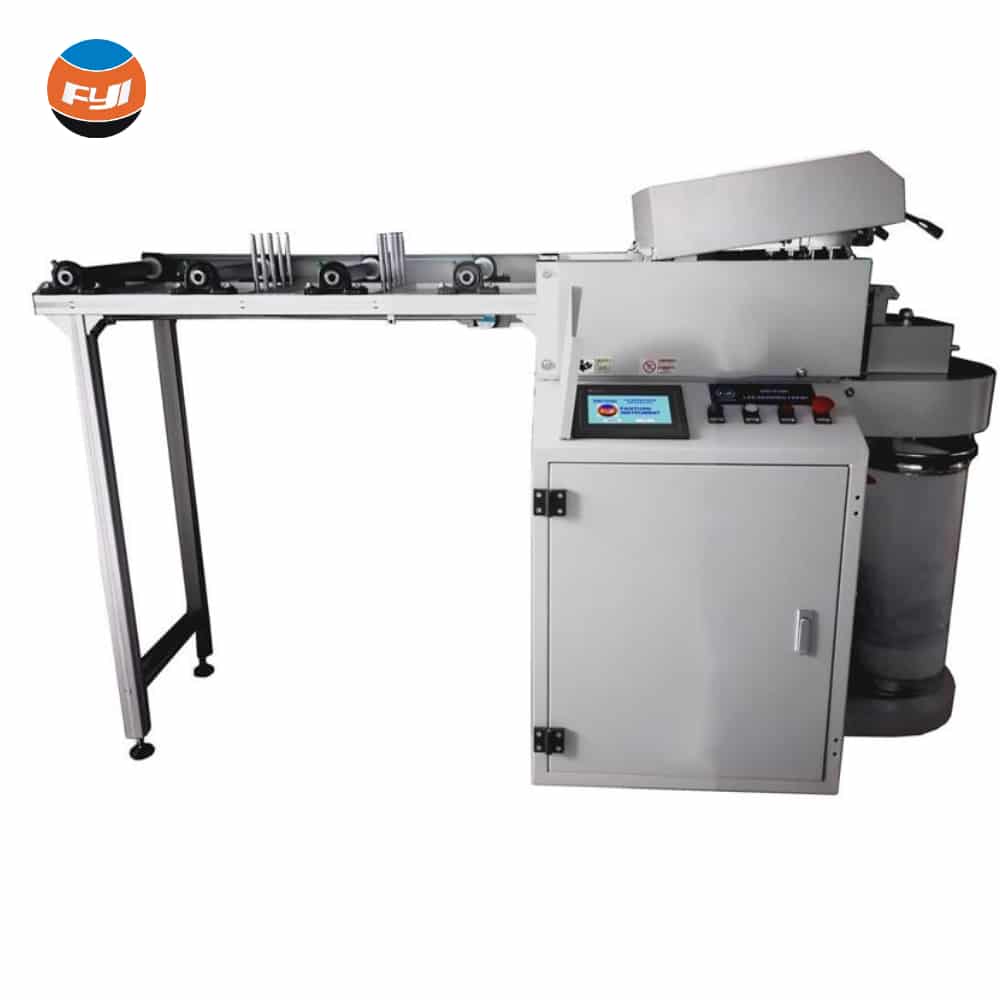
2. Wool Gilling Machine
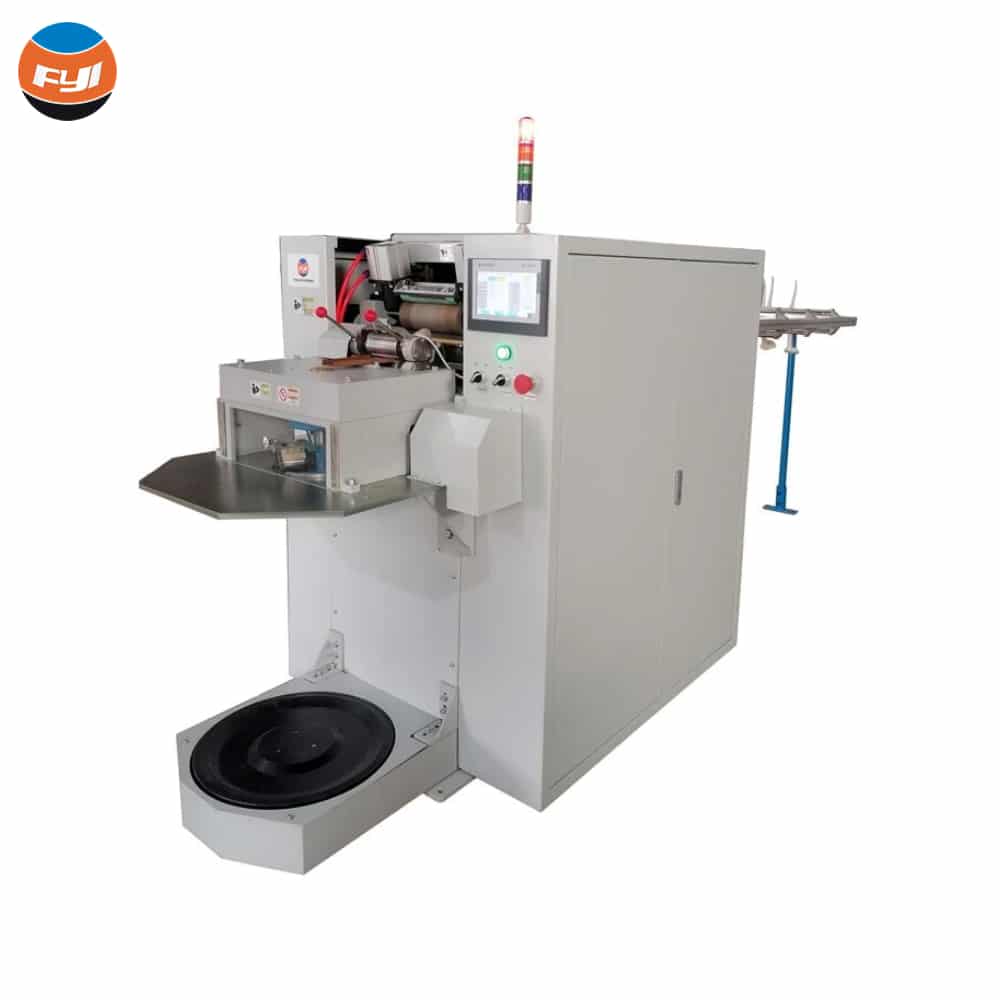
In wool processing, the machine used is called a wool gilling machine, not a draw frame. Wool fibers are different from cotton and have natural waves (crimp), more stretch (elasticity), and a scaly surface. Due to this, the wool gilling machine is built differently to keep these delicate fibers safe. These machines function more slowly than cotton draw frames. They also use specially adapted drafting systems to handle the softness and texture of wool without damaging it.
3. Man-made Fiber Draw Frames
Man-made fiber draw frames work with synthetic fibers such as polyester, nylon, and viscose. These fibers behave differently from natural ones and can be more slippery, sensitive to heat, and prone to static. That’s why synthetic fiber draw frames include extra features. They help control friction, avoid overheating, and reduce static buildup. These machines also handle chemicals and finishing agents added to synthetic fibers during production.
Draw Frames – Based on Technology
Draw frames come in different types depending on their technology used. Each type has unique features that affect how the machine performs and how suitable it is for different spinning needs.
1. Conventional Draw Frames
Conventional draw frames are the older, more traditional draw frames. They don’t have any automatic control system. That’s why, they depend on a method called doubling—combining multiple slivers which make the final sliver more even. These are not advanced as modern machines but still some factories prefer to use them. The reason is they are easyto operate and cost effective to buy and maintain, especially where labor is affordable and available.
2. Autoleveller Draw Frames
Autoleveller draw frames are more modern and smart. They use electronic or mechanical systems to check the thickness of the sliver all the time. If the thickness changes, the machine automatically fixes it by adjusting how much the fibers are stretched (draft). This makes the sliver even, which results in high-quality yarn. These machines are especially helpful when the fiber quality isn’t the same and needs constant adjustments to maintain a stable output.
3. High-Speed Draw Frames
High-speed draw frames are built for fast production. These machines can run at very high speeds—more than 800 meters per minute. They have stronger parts and more effective fiber handling systems to make sure the speed doesn’t lower the quality. Therefore, they are perfect for mills that want to produce more yarn in less time without compromising on quality.
Types of Draw Frames Based on Their Role in the Production Line
Draw frames are used at different points in the spinning process. Their function changes depending on where they are placed in the production flow. Here are the two main types:
1. Breaker Draw Frames
Breaker draw frames are the first machines used in the draw frame section. Their role is to start enhancing the way fibers are lined up and to begin the blending process. At this stage, the settings are kept even to prevent fibers from being damaged. The goal is to prepare the sliver for further processing by making it even, smoother, and more consistent than it was after carding or combing.
2. Finisher Draw Frames
Finisher draw frames come at the end of the draw frame stage. Their role is to create a sliver that is very even and clean, ready for roving and spinning. These machines usually have advanced quality control features to check that the sliver meets exact standards. The settings are more precise, which helps to ensure the final yarn will be strong and even.
How a Draw Frame Works and How It’s Tested?
To understand how draw frames help improve yarn quality, it’s also essential to know how they work. Here are the basic steps involved in the operation and how the equipment ensures consistent results. Let’s have a look:
Basic Working Steps of a Draw Frame
A draw frame works through three main steps that help turn several slivers into one smoother and more even sliver.
The process begins with doubling, where 6 to 8 card slivers are fed into the machine at the same time. The purpose of this step is to balance out the thickness differences between the individual slivers. By combining them, the output becomes more consistent.
Next is drafting, where the combined slivers pass through sets of rollers. During each set of rollers, the speed increases, gently stretching the fibers. This makes the fibers line up better and reduces thickness variations. The drafting ratio (how much the fibers are stretched) is usually between 6 and 8, depending on what kind of yarn is being made.
In the final step, the stretched sliver goes through a funnel-shaped part called a trumpet, which brings the fibers together into a neat, single strand. This strand is then collected in large containers called cans. The relationship of input and output follows this simple formula:
Input sliver linear density × Number of doublings = Output sliver linear density × Draft
Detailed Step-by-Step Process
The full operation of a draw frame includes several stages, each one important for producing high-quality sliver.
Feeding: Slivers from multiple cans are guided into the machine. They pass through plates and are pulled in by feed rollers. Modern machines use sensors to check the tension and make sure the slivers are fed evenly.
Drafting Zone: The slivers go through a group of 3 or 4 roller pairs. These rollers are often arranged in a “4-over-3” design, where four top rollers sit over three bottom rollers. Each roller pair moves faster than the last to stretch the fibers smoothly. Rubber-covered top rollers and spring or air pressure systems keep the slivers in place. A pressure bar helps control the fibers as they pass through.
Condensing and Delivery: After drafting, the sliver enters a trumpet, which shapes it into a clean and uniform strand. Delivery rollers pull the sliver through at a controlled speed. In machines with autolevellers, sensors check the thickness of the sliver and send signals to adjust the roller speed if needed.
Coiling and Can Filling: Finally, the sliver is gently coiled into a rotating can. The coiler ensures it is placed in a spiral shape so it can be used smoothly later. Advanced systems can even change the cans automatically once they’re full.
How Is Draw Frame Performance Tested?
To ensure draw frames work correctly and produce good-quality sliver, several testing methods are used in the textile industry. These tests help maintain yarn quality and machine performance.
1. Sliver Evenness Testing
One of the most important tests checks how even the sliver is. The Uster Evenness Tester is commonly used to measure this. It calculates the Coefficient of Variation (CV%), which shows how much the sliver’s thickness changes. A good CV% is usually between 2.0% and 2.5%. If the variation is too high, it can affect yarn quality. Spectrogram analysis is also used to detect any regular faults, which may be caused by machine problems and need quick fixing.
2. Draft Setting Verification
This test checks how much the fiber is stretched between rollers. It includes three main checks:
- The break draft is calculated from the speed difference between the first two rollers.
- The main draft looks at the speed between the second and final rollers.
- The total draft compares how thick the sliver is before and after drafting.
These checks help ensure that the machine is set correctly and producing the desired output.
3. Fiber Orientation Testing
This test measures how well the fibers are lined up. It uses tracer fibers and imaging tools to see the angle of fiber alignment. Better alignment means smoother and stronger yarn later on. This test is important for checking the draw frame’s drawing quality.
4. Sliver Cohesion Testing
This test checks how well the fibers stick together after drafting. It uses microscope techniques to count the number of leading and trailing hooks—tiny ends that show how well the fibers are controlled. Good fiber control means the sliver is more stable and easier to handle in the next steps.
5. Autoleveller Efficiency Testing
For machines with autolevellers, this test checks how quickly and accurately they adjust sliver thickness. It measures how much the CV% improves from input to output sliver. The test also looks at short-term, medium-term, and long-term sliver variations to ensure the machine works well over time and stays consistent.
Performance and Technical Parameters of Draw Frames
Draw frames play a vital role in the spinning process, and their technical capabilities are crucial for optimal performance. Let’s explore the main parameters that influence their production and mechanical performance.
1. Production Parameters
Modern draw frames operate within specific technical limits that impact their production efficiency. The delivery speed of these machines can vary significantly depending on the model. Standard machines typically run at speeds between 400-600 m/min, while high-speed models can reach 700-1000 m/min. These speeds directly influence the production output, which can range from 450-500 kg/hour per delivery in optimized systems.
The doubling range, which refers to the number of slivers combined during processing, usually falls between 4-8 in cotton processing. This can be adjusted to match the characteristics of different fibers, ensuring better quality and flexibility. Adjusting the doubling range allows mills to fine-tune their machines based on the type of fiber being processed.
The draft range, another important parameter, includes total draft (usually adjustable from 4-12), break draft (maintained between 1.1-1.4 for quality), and main draft (variable between 3-10). These settings impact the fiber arrangement and sliver characteristics, ensuring the desired quality of the final product.
Sliver count range, which measures linear density, typically falls between 2.5-6.0 ktex, corresponding to 40-80 grains per yard. This range allows for both fine and coarse specifications, depending on the process, such as combed or carded processing.
2. Mechanical Parameters
The mechanical features of a draw frame are critical for its efficiency and durability. The drafting system usually employs roller arrangements like 4-over-3 or 3-over-3, with bottom rollers ranging from 25-32 mm in diameter. The hardness of the roller cots varies between 70° and 90° Shore D, ensuring optimal fiber grip and control.
Pressure systems typically operate at 0.1-0.4 MPa, with adjustable settings to suit different fiber types. This flexibility allows for better processing of various fibers. Additionally, modern systems enable individual roller pressure adjustments, offering flexibility during production.
The cans used in draw frames usually have diameters between 400-600 mm and heights ranging from 900-1200 mm. Recently, rectangular cans have become more popular for better space management in modern mill layouts.
3. Control and Monitoring Parameters
Modern draw frames come equipped with advanced electronic systems that significantly improve their performance. Autoleveller systems, for example, respond quickly to variations in sliver quality. Short-term systems react within 3-10 milliseconds, while medium-term systems take 10-50 milliseconds to adjust. These systems can correct sliver variations by ±15% to ±25%, ensuring consistent quality.
Digital scanning systems operate at 500-1000 scans per second, ensuring continuous monitoring of sliver quality across different zones of the machine. This high-speed scanning guarantees that the sliver is constantly assessed for quality.
Sliver monitoring systems set a limit for CV% (coefficient of variation) between 2.0-3.0%, and advanced spectrogram analysis examines wavelengths from 1 cm to 100 m. This analysis helps identify both micro and macro variations in the sliver, ensuring the highest quality output.
4. Energy Consumption
Energy usage is a critical aspect of operational costs. Standard draw frames consume around 3-5 kW per delivery, while high-speed machines require 5-8 kW due to their complex electronics. Overall, energy consumption usually ranges from 0.04-0.08 kWh per kilogram of processed material. This is an important factor for mills to consider when evaluating operational costs.
Recent Technological Developments in Draw Frames
Draw frames have undergone significant technological advancements in recent years, focusing on improving quality control, operational flexibility, and energy efficiency.
1. Autolevelling Systems
Autolevellers are now essential in maintaining high-quality sliver production. Modern systems like SERVO DRAFT ensure that quality is maintained throughout production. Digital autolevellers use advanced algorithms to make real-time adjustments to the draft, achieving a correction accuracy of ±0.5% with response times of 5-10 milliseconds.
2. Advanced Monitoring Technologies
Camera-based sliver monitoring has become a vital tool in quality control. These systems continuously capture images of the sliver and compare them with reference standards using image processing algorithms. When imperfections are detected, the machine parameters are adjusted automatically, minimizing manual inspections.
Microwave sensor technology has also been integrated into draw frames. These sensors can accurately measure fiber mass and moisture content without direct contact, improving efficiency and precision. Additionally, thread monitors use photocell technology to detect irregularities in the sliver, such as thick spots or slubs, and adjust machine settings accordingly.
3. Mechanical Improvements
New technologies, such as the auto break draft setting, optimize sliver quality by calculating the best break draft values in real-time. Systems like CLEAN coil technology from Rieter extend cleaning intervals significantly, improving efficiency when processing man-made fibers.
Pneumatic pressure head systems automatically control the pressure on drafting rollers, ensuring consistent fiber control without the need for manual adjustments. Modern draw frames also feature simplified settings, allowing operators to easily adjust parameters without the need for specialized gauges.
4. Integration with Industry 4.0
Many modern draw frames now integrate with Industry 4.0 technologies, allowing them to communicate in real-time with central management systems. This integration enables remote monitoring, automated adjustments, and predictive maintenance, improving overall efficiency and reducing downtime.
Product Quality and Brand Reputation
Leading draw frame manufacturers, such as Trutzschler (Germany), Rieter (Switzerland), Marzoli (Italy), and Lakshmi Machine Works (India), each have their own strengths and specialized technologies. Trutzschler focuses on advanced autolevelling systems, while Rieter is known for its high-speed production capabilities and energy-efficient designs. Marzoli offers flexible machines with user-friendly interfaces, and Lakshmi provides cost-effective solutions for diverse markets.
FYI, Fanyuan Instrument Manufacturer stands out as the top emerging brand, gaining rapid recognition for its precision engineering and competitive performance across global markets. With a focus on innovation and reliability, FYI’s draw frames consistently deliver excellent sliver evenness and operational stability, often matching or exceeding industry benchmarks.
The quality of a draw frame is primarily determined by its sliver evenness, production stability, and operational flexibility. Premium machines tend to offer better evenness, with CV% values ranging from 1.5–1.8%, while economy models typically produce higher CV% values. High-end machines also maintain consistent quality at higher speeds, contributing to better mill efficiency.
Does the Equipment Comply with Industry Testing Standards?
Draw frames must meet various international standards to ensure safety, quality, and performance. Major standards include:
- ISO 9001:2015 – Ensures proper quality management systems.
- ISO 139:2005 – Defines standardized atmospheric conditions for testing.
- USTER® Statistics – Serves as an industry benchmark for fiber quality.
Additionally, machines must comply with safety standards such as CE Marking (for EU markets) and UL Certification (for North American markets), as well as machinery safety standards like ISO 12100.
Price, Cost-effectiveness, and Maintenance Requirements
Pricing for draw frames varies widely depending on their features, technology, and production capacities. Entry-level machines cost between $30,000 – $60,000 USD, while high-end machines can exceed $250,000 USD, particularly those with advanced autolevelling systems and high production speeds.
The cost-effectiveness of draw frames is typically assessed through return on investment (ROI) calculations, considering factors like production capacity, energy efficiency, and maintenance costs. High-end machines usually show returns within 2-3 years, while mid-range machines offer a quicker ROI of 1.5-2.5 years.
Maintenance requirements vary, with daily, weekly, and monthly procedures to keep the machine in optimal working condition. Regular checks and component replacements ensure the machine’s longevity and consistent performance.
Conclusion
Draw frames are essential for high-quality yarn production. With advanced features like autolevellers, digital control systems, and integrated monitoring technologies, modern machines provide improved sliver consistency and operational flexibility.
When selecting a draw frame, manufacturers must consider factors such as production requirements, fiber types, and budget constraints to make the best investment decision. Looking forward, the continued integration of Industry 4.0 technologies will further enhance the efficiency and capabilities of draw frames.
For more detailed information about lab drawing frames and their applications, visit FYI Tester’s Draw Frame page or check out their Lab Drawing Frame products.
Frequently Asked Questions
Q1: What is the ideal CV% for the draw frame sliver?
The ideal CV% for draw frame sliver typically ranges from 1.5% to 2.5%. Premium machines can achieve values on the lower end of this range. According to industry standards, a CV% greater than 2.5% is considered high and may indicate mechanical issues or improper settings.
Q2: How often should draw frame top roller cots be replaced?
Top roller cots should typically be replaced every 6-12 months, depending on production volume and fiber type. Signs that indicate replacement is needed include surface roughness, reduced diameter (after multiple buffings), hardness changes, and visible damage like cuts or cracks.
Q3: What are the common causes of high sliver unevenness in draw frames?
Common causes include improper roller settings, incorrect total draft, eccentricity of drafting rollers, poor top roller conditions, incorrect pressure bar settings, improper trumpet condenser selection, tension draft issues, and imperfect autoleveller settings. Regular maintenance and proper setup are essential to minimize these issues.
Q4: How does an autoleveller draw frame differ from a conventional one? Autoleveller draw frames incorporate sensing devices that detect variations in input sliver thickness and automatically adjust the draft to produce a more consistent output sliver. Conventional draw frames rely solely on the doubling effect to improve evenness without any automatic correction mechanisms.
